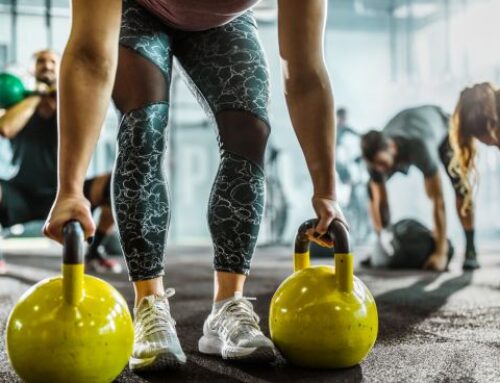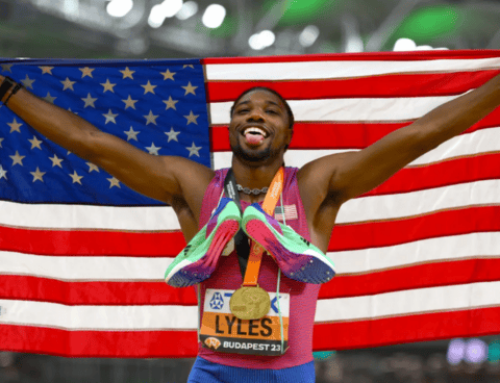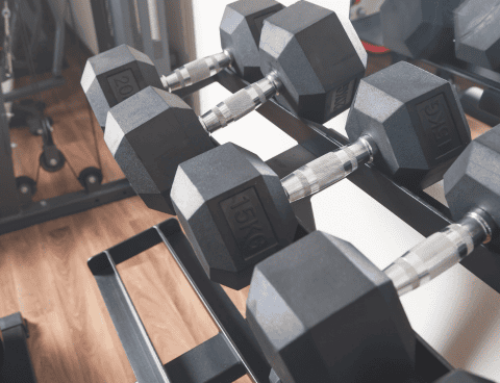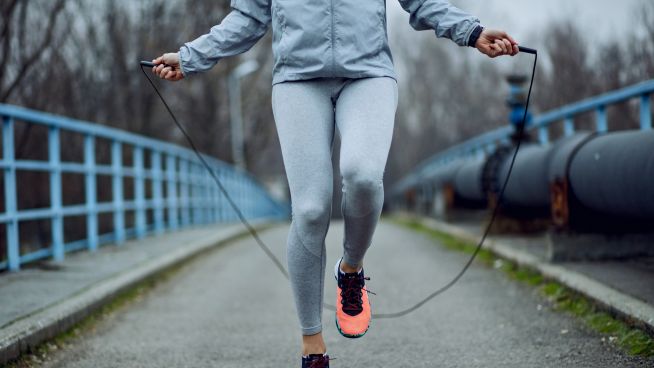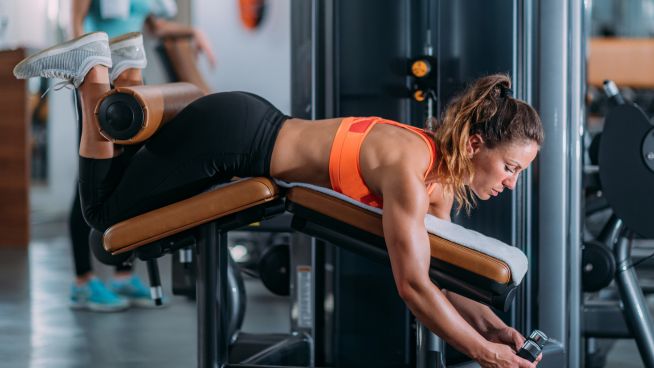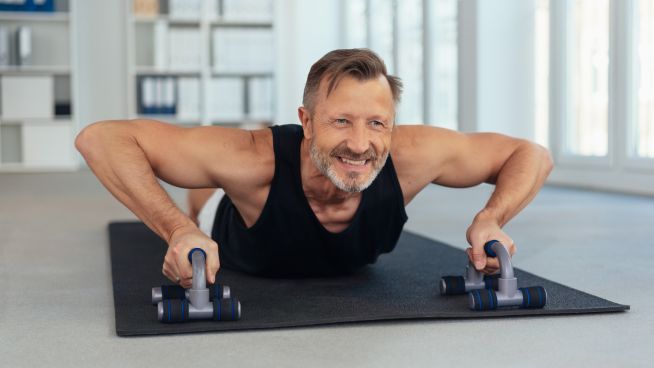Why You Must Consider Specificity When Planning a Workout
![]()
Specificity—a focus on particular muscles, movements, energy systems and velocity—drives the gains you make in training and practice. If you don’t deliberately train for something, it may not happen.
Let’s take a closer look at specificity, then go through some real world examples of how to apply this important principle.
Muscles
If you want to develop certain muscles, you have to do exercises that engage those muscles. Performing the Leg Press is not a good way to develop your chest muscles.
Because athletes don’t have all day to train like bodybuilders, they normally group exercises into several categories: pushing, pulling, squats, hip extensions and one-legged exercises.
- Pushing exercises are exercises like Presses that develop the chest, shoulders and triceps.
- Pulling exercise include Rows, Pulldowns, and Pull-Ups, which develop the upper back, shoulders, and biceps.
- Squats involve sitting down and standing up against resistance. They are critical to athletic performance and develop pretty much every muscle from the waist down. They include Back Squats, Front Squats, Overhead Squats, Pause Squats and Eccentric Squats.
- Hip extension exercises train the hamstrings, lower back and glutes. They work the hamstrings in a lengthened position, which is important for sprinting and most sports skills. They include Deadlifts, Romanian Deadlifts, Good Mornings and Back Raises.
- One-legged exercises focus on one leg more than the other. This is important for sports, because you never run with both legs on the ground at the same tine, and you frequently lever off one side of the body to throw or kick. These include exercises like Lunges, Step-Ups, One-Legged Squats and Split-Squats, which work pretty much every muscle from the waist down.
Movements
Sports skills have to be practiced to be improved—and they have to be practiced correctly. Bad habits carry over to game performance.
It takes thousands of repetitions to master a sports skill, and it must be maintained over your entire athletic career. For example, if you want to get better at free throws, you have to deliberately focus on practicing them, with perfect form, for a long time each day.
Energy Systems
Recall that there are three energy systems:
- An immediate/high-intensity system that fuels 6-10 seconds of exercise—e.g., a maximum lift, running the 40, a vertical jump.
- A short-term energy system that fuels two to three minutes of exercise—e.g., running the 400, performing Sit-Ups for two minutes.
- An aerobic energy system that fuels lower intensity exercise until the fuel runs out—e.g., running a 10K.
Strength and conditioning professionals analyze a sport to determine its dominant energy system and put together programs that focus on that system. For example, a shot putter does not require much work in the aerobic energy system, but he or she needs a lot of work in the short-term system. A wide receiver needs a lot of work in the immediate and short-term energy systems, but not much in the aerobic.
Velocity
To be fast and explosive, you have to train that way. This applies to running, jumping, changing directions, throwing, kicking and most other sports skills. It’s fine to learn the skills at slower speeds, but you have to practice them at faster speeds to improve them. In the weight room, we use Olympic lifts, plyometrics and medicine ball throws to improve these attributes. Outside the weight room, we focus on sprints and agility drills. Training slowly means you get better at slow speeds.
The following are two sample programs that use all of the above and show you how specificity dictates the exercises and type of workout. The first focuses on improving the Bench Press. The second focuses on improving 40-Yard Dash time.
Bench Press
A maximal Bench Press is performed in 6-10 seconds, so it uses the immediate energy system for fuel. It involves the chest, shoulders and triceps working together in a specific motor pattern. It is performed at a slow velocity because it involves maximal weights.
With that in mind, a program focusing on increasing your Bench Press maximum might look like this:
Day One
- Bench Press: 5×4-8@80-90%
- Dumbbell Shoulder Raises: 3×4-8
- Lying Triceps Extensions: 3×4-8
- Seated Rows, bench press grip: 5×4-8
Day Four
- Floor Press: 5×4-8@80-90%
- Pause Bench Press: 3×3-6@70-80%
- Seated Military Press: 3×4-8
- Bent-Over Rows, bench press grip: 3×4-8
40-Yard Dash
The 40 involves a specific and coordinated movement pattern that balances an explosive start, the ability to accelerate and the ability to achieve a high running velocity. To do this, the athlete needs to know how to start and how to run over this distance. It is very fast and primarily fueled by the immediate energy system. With that in mind, a program focusing on improving the 40 might look like this:
Day One
- Mobility drills: 10 minutes
- Hamstring drills:
- Marches: 3×20 yards
- Inchworms: 3×20 yards
- Reverse Crabwalks: 3×20 yards
- Sprinting technique drills:
- High knee drills, 2-3×20-30 yards
- A-drills, 2-3×20-30 yards
- Falling Starts: 2×5 yards
- Standing Starts: 2×5 yards
- Crouching Starts: 2x3x10 yards
- Bound: 3×20 yards
Day Four
- Mobility drills: 10 minutes
- Hamstring drills:
- Marches, 3×20 yards
- Inchworms: 3×20 yards
- Reverse Crabwalks: 3×20 yards
- Sprinting technique drills:
- High knee drills, 2-3×20-30 yards
- A-drills, 2-3×20-30 yards
- Flying Sprints: 5×20 yard acceleration + 40 yard sprint
- Bounds: 3×40 yards
- Sled Pushes: 3×40 yards
READ MORE:
[cf]skyword_tracking_tag[/cf]RECOMMENDED FOR YOU
MOST POPULAR
Why You Must Consider Specificity When Planning a Workout
![]()
Specificity—a focus on particular muscles, movements, energy systems and velocity—drives the gains you make in training and practice. If you don’t deliberately train for something, it may not happen.
Let’s take a closer look at specificity, then go through some real world examples of how to apply this important principle.
Muscles
If you want to develop certain muscles, you have to do exercises that engage those muscles. Performing the Leg Press is not a good way to develop your chest muscles.
Because athletes don’t have all day to train like bodybuilders, they normally group exercises into several categories: pushing, pulling, squats, hip extensions and one-legged exercises.
- Pushing exercises are exercises like Presses that develop the chest, shoulders and triceps.
- Pulling exercise include Rows, Pulldowns, and Pull-Ups, which develop the upper back, shoulders, and biceps.
- Squats involve sitting down and standing up against resistance. They are critical to athletic performance and develop pretty much every muscle from the waist down. They include Back Squats, Front Squats, Overhead Squats, Pause Squats and Eccentric Squats.
- Hip extension exercises train the hamstrings, lower back and glutes. They work the hamstrings in a lengthened position, which is important for sprinting and most sports skills. They include Deadlifts, Romanian Deadlifts, Good Mornings and Back Raises.
- One-legged exercises focus on one leg more than the other. This is important for sports, because you never run with both legs on the ground at the same tine, and you frequently lever off one side of the body to throw or kick. These include exercises like Lunges, Step-Ups, One-Legged Squats and Split-Squats, which work pretty much every muscle from the waist down.
Movements
Sports skills have to be practiced to be improved—and they have to be practiced correctly. Bad habits carry over to game performance.
It takes thousands of repetitions to master a sports skill, and it must be maintained over your entire athletic career. For example, if you want to get better at free throws, you have to deliberately focus on practicing them, with perfect form, for a long time each day.
Energy Systems
Recall that there are three energy systems:
- An immediate/high-intensity system that fuels 6-10 seconds of exercise—e.g., a maximum lift, running the 40, a vertical jump.
- A short-term energy system that fuels two to three minutes of exercise—e.g., running the 400, performing Sit-Ups for two minutes.
- An aerobic energy system that fuels lower intensity exercise until the fuel runs out—e.g., running a 10K.
Strength and conditioning professionals analyze a sport to determine its dominant energy system and put together programs that focus on that system. For example, a shot putter does not require much work in the aerobic energy system, but he or she needs a lot of work in the short-term system. A wide receiver needs a lot of work in the immediate and short-term energy systems, but not much in the aerobic.
Velocity
To be fast and explosive, you have to train that way. This applies to running, jumping, changing directions, throwing, kicking and most other sports skills. It’s fine to learn the skills at slower speeds, but you have to practice them at faster speeds to improve them. In the weight room, we use Olympic lifts, plyometrics and medicine ball throws to improve these attributes. Outside the weight room, we focus on sprints and agility drills. Training slowly means you get better at slow speeds.
The following are two sample programs that use all of the above and show you how specificity dictates the exercises and type of workout. The first focuses on improving the Bench Press. The second focuses on improving 40-Yard Dash time.
Bench Press
A maximal Bench Press is performed in 6-10 seconds, so it uses the immediate energy system for fuel. It involves the chest, shoulders and triceps working together in a specific motor pattern. It is performed at a slow velocity because it involves maximal weights.
With that in mind, a program focusing on increasing your Bench Press maximum might look like this:
Day One
- Bench Press: 5×4-8@80-90%
- Dumbbell Shoulder Raises: 3×4-8
- Lying Triceps Extensions: 3×4-8
- Seated Rows, bench press grip: 5×4-8
Day Four
- Floor Press: 5×4-8@80-90%
- Pause Bench Press: 3×3-6@70-80%
- Seated Military Press: 3×4-8
- Bent-Over Rows, bench press grip: 3×4-8
40-Yard Dash
The 40 involves a specific and coordinated movement pattern that balances an explosive start, the ability to accelerate and the ability to achieve a high running velocity. To do this, the athlete needs to know how to start and how to run over this distance. It is very fast and primarily fueled by the immediate energy system. With that in mind, a program focusing on improving the 40 might look like this:
Day One
- Mobility drills: 10 minutes
- Hamstring drills:
- Marches: 3×20 yards
- Inchworms: 3×20 yards
- Reverse Crabwalks: 3×20 yards
- Sprinting technique drills:
- High knee drills, 2-3×20-30 yards
- A-drills, 2-3×20-30 yards
- Falling Starts: 2×5 yards
- Standing Starts: 2×5 yards
- Crouching Starts: 2x3x10 yards
- Bound: 3×20 yards
Day Four
- Mobility drills: 10 minutes
- Hamstring drills:
- Marches, 3×20 yards
- Inchworms: 3×20 yards
- Reverse Crabwalks: 3×20 yards
- Sprinting technique drills:
- High knee drills, 2-3×20-30 yards
- A-drills, 2-3×20-30 yards
- Flying Sprints: 5×20 yard acceleration + 40 yard sprint
- Bounds: 3×40 yards
- Sled Pushes: 3×40 yards
READ MORE:


